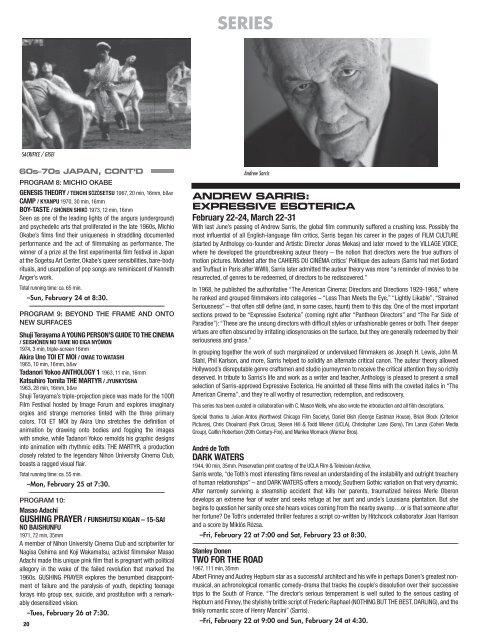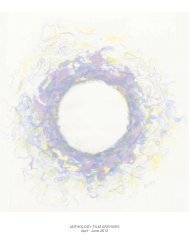quarterly pdf - Anthology Film Archives
quarterly pdf - Anthology Film Archives
quarterly pdf - Anthology Film Archives
You also want an ePaper? Increase the reach of your titles
YUMPU automatically turns print PDFs into web optimized ePapers that Google loves.
SACRIFICE / GISEI<br />
60s–70s JAPAN, CONT’D<br />
PROGRAM 8: MICHIO OKABE<br />
GENESIS THEORY / TENCHI SZSETSU 1967, 20 min, 16mm, b&w<br />
CAMP / KYANPU 1970, 30 min, 16mm<br />
BOY-TASTE / SHNEN SHIK 1973, 12 min, 16mm<br />
Seen as one of the leading lights of the angura (underground)<br />
and psychedelic arts that proliferated in the late 1960s, Michio<br />
Okabe’s fi lms fi nd their uniqueness in straddling documented<br />
performance and the act of fi lmmaking as performance. The<br />
winner of a prize at the fi rst experimental fi lm festival in Japan<br />
at the Sogetsu Art Center, Okabe’s queer sensibilities, bare-body<br />
rituals, and usurpation of pop songs are reminiscent of Kenneth<br />
Anger’s work.<br />
Total running time: ca. 65 min.<br />
–Sun, February 24 at 8:30.<br />
–––––––––––––––––––––––––––––––––––––––––––––––––––––––––––––––––––––––––––––––––––––––––––––––––––<br />
PROGRAM 9: BEYOND THE FRAME AND ONTO<br />
NEW SURFACES<br />
Shuji Terayama A YOUNG PERSON’S GUIDE TO THE CINEMA<br />
/ SEISHNEN NO TAME NO EIGA NYMON<br />
1974, 3 min, triple-screen 16mm<br />
Akira Uno TOI ET MOI / OMAE TO WATASHI<br />
1965, 10 min, 16mm, b&w<br />
Tadanori Yokoo ANTHOLOGY 1 1963, 11 min, 16mm<br />
Katsuhiro Tomita THE MARTYR / JYUNKYSHA<br />
1963, 28 min, 16mm, b&w<br />
Shuji Terayama’s triple-projection piece was made for the 100ft<br />
<strong>Film</strong> Festival hosted by Image Forum and explores imaginary<br />
orgies and strange memories tinted with the three primary<br />
colors. TOI ET MOI by Akira Uno stretches the defi nition of<br />
animation by drawing onto bodies and fogging the images<br />
with smoke, while Tadanori Yokoo remolds his graphic designs<br />
into animation with rhythmic edits. THE MARTYR, a production<br />
closely related to the legendary Nihon University Cinema Club,<br />
boasts a ragged visual fl air.<br />
Total running time: ca. 55 min.<br />
–Mon, February 25 at 7:30.<br />
–––––––––––––––––––––––––––––––––––––––––––––––––––––––––––––––––––––––––––––––––––––––––––––––––––<br />
PROGRAM 10:<br />
Masao Adachi<br />
GUSHING PRAYER / FUNSHUTSU KIGAN – 15-SAI<br />
NO BAISHUNFU<br />
1971, 72 min, 35mm<br />
A member of Nihon University Cinema Club and scriptwriter for<br />
Nagisa Oshima and Koji Wakamatsu, activist fi lmmaker Masao<br />
Adachi made this unique pink fi lm that is pregnant with political<br />
allegory in the wake of the failed revolution that marked the<br />
1960s. GUSHING PRAYER explores the benumbed disappointment<br />
of failure and the paralysis of youth, depicting teenage<br />
forays into group sex, suicide, and prostitution with a remarkably<br />
desensitized vision.<br />
20<br />
–Tues, February 26 at 7:30.<br />
SERIES<br />
Andrew Sarris<br />
ANDREW SARRIS:<br />
EXPRESSIVE ESOTERICA<br />
February 22-24, March 22-31<br />
With last June’s passing of Andrew Sarris, the global fi lm community suffered a crushing loss. Possibly the<br />
most infl uential of all English-language fi lm critics, Sarris began his career in the pages of FILM CULTURE<br />
(started by <strong>Anthology</strong> co-founder and Artistic Director Jonas Mekas) and later moved to the VILLAGE VOICE,<br />
where he developed the groundbreaking auteur theory – the notion that directors were the true authors of<br />
motion pictures. Modeled after the CAHIERS DU CINÉMA critics’ Politique des auteurs (Sarris had met Godard<br />
and Truffaut in Paris after WWII), Sarris later admitted the auteur theory was more “a reminder of movies to be<br />
resurrected, of genres to be redeemed, of directors to be rediscovered.”<br />
In 1968, he published the authoritative “The American Cinema: Directors and Directions 1929-1968,” where<br />
he ranked and grouped fi lmmakers into categories – “Less Than Meets the Eye,” “Lightly Likable”, “Strained<br />
Seriousness” – that often still defi ne (and, in some cases, haunt) them to this day. One of the most important<br />
sections proved to be “Expressive Esoterica” (coming right after “Pantheon Directors” and “The Far Side of<br />
Paradise”): “These are the unsung directors with diffi cult styles or unfashionable genres or both. Their deeper<br />
virtues are often obscured by irritating idiosyncrasies on the surface, but they are generally redeemed by their<br />
seriousness and grace.”<br />
In grouping together the work of such marginalized or undervalued fi lmmakers as Joseph H. Lewis, John M.<br />
Stahl, Phil Karlson, and more, Sarris helped to solidify an alternate critical canon. The auteur theory allowed<br />
Hollywood’s disreputable genre craftsmen and studio journeymen to receive the critical attention they so richly<br />
deserved. In tribute to Sarris’s life and work as a writer and teacher, <strong>Anthology</strong> is pleased to present a small<br />
selection of Sarris-approved Expressive Esoterica. He anointed all these fi lms with the coveted italics in “The<br />
American Cinema”, and they’re all worthy of resurrection, redemption, and rediscovery.<br />
This series has been curated in collaboration with C. Mason Wells, who also wrote the introduction and all fi lm descriptions.<br />
Special thanks to Julian Antos (Northwest Chicago <strong>Film</strong> Society), Daniel Bish (George Eastman House), Brian Block (Criterion<br />
Pictures), Chris Chouinard (Park Circus), Steven Hill & Todd Wiener (UCLA), Christopher Lane (Sony), Tim Lanza (Cohen Media<br />
Group), Caitlin Robertson (20th Century-Fox), and Marilee Womack (Warner Bros).<br />
André de Toth<br />
DARK WATERS<br />
1944, 90 min, 35mm. Preservation print courtesy of the UCLA <strong>Film</strong> & Television Archive.<br />
Sarris wrote, “de Toth’s most interesting fi lms reveal an understanding of the instability and outright treachery<br />
of human relationships” – and DARK WATERS offers a moody, Southern Gothic variation on that very dynamic.<br />
After narrowly surviving a steamship accident that kills her parents, traumatized heiress Merle Oberon<br />
develops an extreme fear of water and seeks refuge at her aunt and uncle’s Louisiana plantation. But she<br />
begins to question her sanity once she hears voices coming from the nearby swamp…or is that someone after<br />
her fortune? De Toth’s underrated thriller features a script co-written by Hitchcock collaborator Joan Harrison<br />
and a score by Miklós Rózsa.<br />
–Fri, February 22 at 7:00 and Sat, February 23 at 8:30.<br />
–––––––––––––––––––––––––––––––––––––––––––––––––––––––––––––––––––––––––––––––––––––––––––––––––––––––––––––––––––––––––––––––––––––––––––––––––––––––––––––––––––––––––––––––––––––––––––––––––––<br />
Stanley Donen<br />
TWO FOR THE ROAD<br />
1967, 111 min, 35mm<br />
Albert Finney and Audrey Hepburn star as a successful architect and his wife in perhaps Donen’s greatest nonmusical,<br />
an achronological romantic comedy-drama that tracks the couple’s dissolution over their successive<br />
trips to the South of France. “The director’s serious temperament is well suited to the serious casting of<br />
Hepburn and Finney, the stylishly brittle script of Frederic Raphael (NOTHING BUT THE BEST, DARLING), and the<br />
tinkly romantic score of Henry Mancini” (Sarris).<br />
–Fri, February 22 at 9:00 and Sun, February 24 at 4:30.




